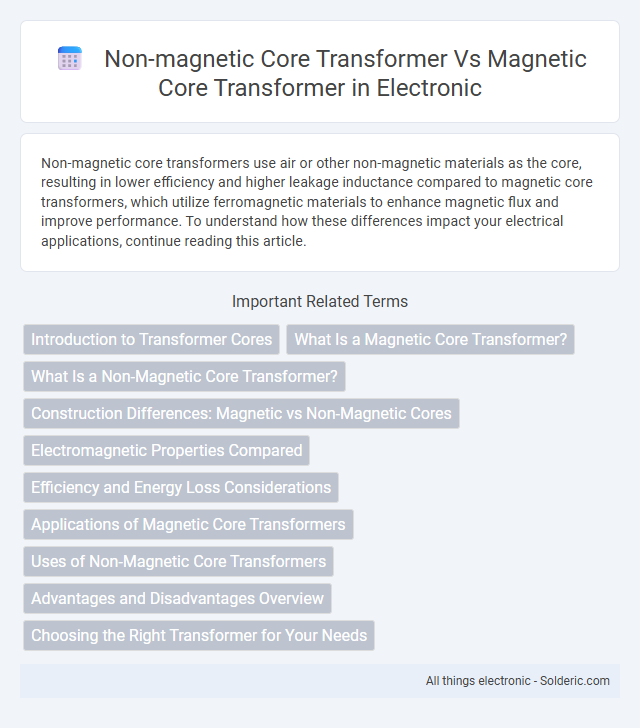Non-magnetic core transformers use air or other non-magnetic materials as the core, resulting in lower efficiency and higher leakage inductance compared to magnetic core transformers, which utilize ferromagnetic materials to enhance magnetic flux and improve performance. To understand how these differences impact your electrical applications, continue reading this article.
Comparison Table
| Feature | Non-Magnetic Core Transformer | Magnetic Core Transformer |
|---|---|---|
| Core Material | Air or non-magnetic materials | Ferromagnetic materials (iron, silicon steel) |
| Magnetic Properties | No magnetic flux concentration | High magnetic flux concentration |
| Efficiency | Lower efficiency due to weak magnetic coupling | Higher efficiency with strong magnetic coupling |
| Applications | High frequency, radio transformers, isolation | Power transformers, distribution, industrial use |
| Size and Weight | Generally larger and lighter | Compact and heavier |
| Losses | Low core losses, higher leakage | Core losses like hysteresis and eddy currents |
| Cost | Typically higher due to design complexity | Generally lower for power applications |
Introduction to Transformer Cores
Transformer cores are essential components designed to channel magnetic flux efficiently between the primary and secondary windings. Non-magnetic core transformers use alternative materials to minimize magnetic losses and prevent core saturation, optimizing performance in specific applications like high-frequency circuits. Magnetic core transformers, typically made from laminated silicon steel, offer high magnetic permeability and low hysteresis, which enhances energy transfer efficiency in power distribution and general-purpose transformers.
What Is a Magnetic Core Transformer?
A magnetic core transformer utilizes a core made from ferromagnetic materials such as laminated silicon steel to efficiently channel magnetic flux between primary and secondary windings, enhancing energy transfer. This design minimizes energy losses by concentrating the magnetic field, resulting in higher efficiency and reduced heat generation compared to air-core or non-magnetic core transformers. The magnetic core significantly improves voltage regulation and performance in power distribution and electrical devices.
What Is a Non-Magnetic Core Transformer?
A non-magnetic core transformer uses materials like air or plastic instead of traditional ferromagnetic cores such as iron or ferrite, resulting in negligible magnetic permeability. This design minimizes core losses caused by hysteresis and eddy currents, making it ideal for high-frequency or specialized applications. Without a magnetic core to concentrate the magnetic flux, these transformers rely on the coil geometry and mutual inductance for energy transfer.
Construction Differences: Magnetic vs Non-Magnetic Cores
Magnetic core transformers utilize ferromagnetic materials such as iron or silicon steel, which provide a low-reluctance path for magnetic flux, enhancing efficiency and minimizing energy losses. Non-magnetic core transformers, on the other hand, use cores made from materials with little or no magnetic permeability, such as air or plastic, resulting in higher core losses and reduced efficiency but offering advantages in weight and electromagnetic interference. Your choice between these two transformer types depends on specific application requirements, including efficiency, size constraints, and the need for noise reduction.
Electromagnetic Properties Compared
Non-magnetic core transformers use materials like air or plastic, resulting in low magnetic permeability and minimal core losses, making them ideal for high-frequency applications. Magnetic core transformers, typically made from iron or ferrite, exhibit high magnetic permeability, enhancing their efficiency by concentrating magnetic flux and reducing energy losses during power transfer. Your choice depends on the specific electromagnetic requirements, such as frequency range and efficiency needs, where magnetic cores excel in low-frequency and high-power scenarios, while non-magnetic cores are preferred for insulation and frequency-sensitive designs.
Efficiency and Energy Loss Considerations
Non-magnetic core transformers, often using air or vacuum cores, exhibit lower energy losses due to the absence of hysteresis and eddy current losses typical in magnetic core transformers. However, magnetic core transformers, typically made from laminated silicon steel, achieve higher efficiency by concentrating magnetic flux and minimizing leakage inductance. Your choice between the two depends on efficiency needs, with magnetic core transformers generally providing superior performance in energy-sensitive applications.
Applications of Magnetic Core Transformers
Magnetic core transformers are widely used in power distribution systems due to their high efficiency and ability to handle large currents and voltages. They are essential in electrical grids, industrial machinery, and audio equipment for voltage regulation and signal isolation. These transformers provide better magnetic flux control, making them ideal for applications requiring stable and reliable power transfer.
Uses of Non-Magnetic Core Transformers
Non-magnetic core transformers are commonly used in applications requiring minimal electromagnetic interference, such as sensitive audio equipment, medical devices, and precision measuring instruments. Their non-magnetic cores reduce core losses and enhance signal clarity, making them ideal for high-frequency operations and environments where magnetic saturation must be avoided. You benefit from improved efficiency and noise reduction when choosing non-magnetic core transformers for specialized industrial or electronic applications.
Advantages and Disadvantages Overview
Non-magnetic core transformers, often made from air or vacuum, offer advantages such as reduced core losses, minimal hysteresis, and immunity to magnetic saturation, making them ideal for high-frequency applications and sensitive electronic equipment. However, they tend to be larger, less efficient at low frequencies, and more expensive compared to magnetic core transformers, which use ferromagnetic materials to achieve higher magnetic flux density and improved efficiency in power distribution. Your choice depends on application requirements, balancing factors like frequency range, efficiency, size, and cost.
Choosing the Right Transformer for Your Needs
Non-magnetic core transformers, such as air-core types, offer low core losses and high-frequency operation, making them ideal for applications requiring minimal electromagnetic interference and precise signal transfer. Magnetic core transformers provide higher efficiency and better performance in power distribution due to their ferromagnetic materials, which enhance magnetic flux and reduce energy loss. When choosing the right transformer for your needs, consider factors like operating frequency, efficiency requirements, and electromagnetic compatibility to determine if a non-magnetic or magnetic core design best suits your application.
non-magnetic core transformer vs magnetic core transformer Infographic

 solderic.com
solderic.com